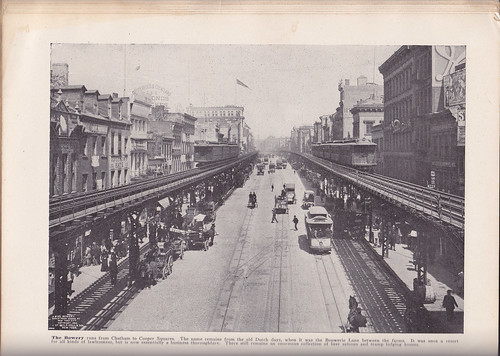 Courtesy of Tim SchreierA photograph of The Bowery in the 19th century showing the elevated railroads.
Courtesy of Tim SchreierA photograph of The Bowery in the 19th century showing the elevated railroads.Kerri Culhane’s lightning-speed, three-minute presentation at the Community Board 2 meeting held at Our Lady of Pompeii Church on Monday provided little indication of the vast research she has gathered in seeking to create a Bowery National Historic District which would span the approximately mile-long avenue, which runs from Chatham Square to Cooper Square .
Currently, individual buildings on the Bowery including The Bowery Savings Bank and Bouwerie Lane Theater have been designated National Historic Landmarks, along with limited portions of the Bowery being included in already designated National Historic Districts. The effort is being co-sponsored by the Bowery Alliance of Neighbors and The Two Bridges Neighborhood Council.
Former NYC Landmarks Preservation Commissioner Anthony Tung has described the “disjointed beauty” of the assemblage of buildings which line the former Native American foot path and later road leading to Peter Stuyvesant’s farm or “bouwerie” from which the street took its name.
Ms. Culhane, an architectural historian who has written for The Local on the significance of 35 Cooper Square, has been involved with architectural preservation on the Lower East Side for nearly a decade, as well as having undertaken historic preservation projects in upstate New York, Washington D.C. and Virginia. She has authored three successful National Historic District nominations, helping create The Lower East Side Historic District Boundary Increase (2003), the Two Bridges Historic District (2004), and the Chinatown & Little Italy Historic District (2009). In 2010, she was honored with a New York State Historic Preservation Award for outstanding National Historic District nomination. The current application includes unprotected buildings along the east side of the Bowery.
Ms. Culhane’s fervor is apparent as she explained the exhaustive process for gaining State and National Historic District designation. The initial step, which has already been completed and approved is creating a draft statement laying out the architectural and historical significance of the district and applying for New York State Historic District designation. The application includes extensive photographic documentation along with a list of all property owners who will be effected. Following state review, a hearing is held which allows all property owners and other interested parties an opportunity to voice their sentiments and concerns. Being declared a State or National Historic District is an honorific designation which does not place limits on property owners regarding selling, altering, or disposing of their properties.
As such, the process is usually not as contentious as being named a NYC Landmark or Landmark District which places restrictions on how a property can be altered or destroyed. Along with bringing local, state and national attention to the historical significance of the Bowery area, being added to the State and National Historic Registers carries tax benefits for property owners, as well as the opportunity to seek grants to rehabilitate their properties. It will also assist in developing cohesive planning for the area.
Last week, in a letter to the Bowery Alliance, the NYS Office of Parks, Recreation and Historic Preservation issued a formal Determination of Eligibility, informing the Alliance that their application met the criteria for being named a NYS State Historic District, an important step in gaining such recognition. Kathleen Howe, Historic Program Preservation Analyst, wrote “The Bowery is a palimpsest of New York City history. While the Bowery has continually changed over its 350-year Euro-American history, its orientation, architectural resources and its integrity of location, setting, feeling and association continue to reflect its iconic place in American history and culture. This long and distinctive avenue and its associated buildings and sites remain a richly layered repository of social, economic, political, cultural and architectural history.”
Thus the process for adding the Bowery to the State Register of Historic Districts appears well on its way, with a public community meeting the next step. Following being named a State Historic District, the application is forwarded by the State Office of Parks, Recreation and Historic Preservation to be considered for addition to the National Register. The Local will be on the lookout for further developments.




